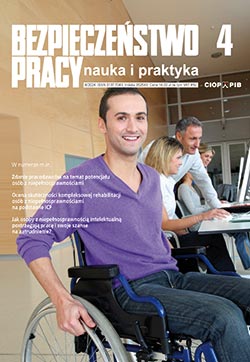Bioaerosols in indoor workplaces - hazards and their sources
Małgorzata Gołofit-Szymczak, Anna Ławniczek - Wałczyk, Rafał Górny
Indoor air quality is a major determinant of people’s health and well-being. Air quality in buildings depends on numerous biological, chemical and dust contaminants as well as microclimate parameters. People, construction materials, ventilation (air-conditioning) systems and outdoor air are major sources of microbial contamination indoors. In an indoor environment, biological agents (e.g., bacteria, fungi, endotoxins, glucans or mycotoxins) transported via air can cause numerous adverse health outcomes in exposed individuals.
Individual cooling systems reducing body heat during work in a hot environment
Grażyna Bartkowiak, Anna Dąbrowska
Hazards posed by thermal load while working in a hot environment make it necessary to eliminate or reduce the accumulation of heat in the body. Hot microclimate should not put workers at risk. Therefore, numerous studies have been undertaken to design an efficient cooling system, based on different cooling factors. That system would absorb excessive heat generated by the body at work. This article analyses existing solutions of individual cooling body systems in the context of developing an ergonomic personal cooling system that provides thermal comfort in a hot environment at a workstation with limited mobility.
User control over the physical condition of connectors in personal equipment protecting against falls from a height
Krzysztof Baszczyński
Personal equipment protecting against falls from a height plays a very important role safeguarding people at hazardous worksites associated with the risk of fall to a lower level, especially in civil engineering, power engineering, telecommunications or mining. To perform properly in their specific protective functions, the components of the system must be connected with one another by means of elements known as the connectors. These tools are commonly used in the terminal portions of connecting and shock-absorbing subsystems, where they must be reliable and maintain the appropriate protective properties throughout the whole period of use. Therefore, it is necessary for their physical condition to be controlled directly by the users as well as by specially trained persons in the workplace. Such inspections require that the user should possess the relevant knowledge, based on instructions, user’s manuals accompanying the equipment, training materials supplied by the manufacturers, etc. This paper contains information that will assist users in inspecting the physical condition of connectors in personal equipment protecting against falls from a height.
A procedure for designing acoustic treatment of educational rooms
Witold Mikulski
This article presents common criteria for assessing rooms in terms of speech intelligibility. The most commonly used parameter of the speech transmission index STI was selected to assess speech intelligibility. It was assumed that its value in a room should not exceed 0.70, which ensures so-called good intelligibility in classrooms. Further on, the article presents a procedure for obtaining good intelligibility. That proposal determines the acoustic treatment of a room, including installing a sound absorbing suspended ceiling and using sound absorbing materials on the walls. This article presents sample practical applications of these guidelines in three classrooms, which verified the effectiveness of the proposal.
Selectivity of absorptive atomic spectrometry in analysing workplace air
Jolanta Surgiewicz
This paper analyses issues related to air samples collected in industrial conditions with atomic absorption spectrometry to assess exposure to harmful chemicals. It discusses the types of interferences that could affect the outcome of an analysis with this method. It presents examples of interferences occurring in air analysis in some industrial processes as well as different ways of eliminating chemical interferences to ensure the quality of the analytical result.




























